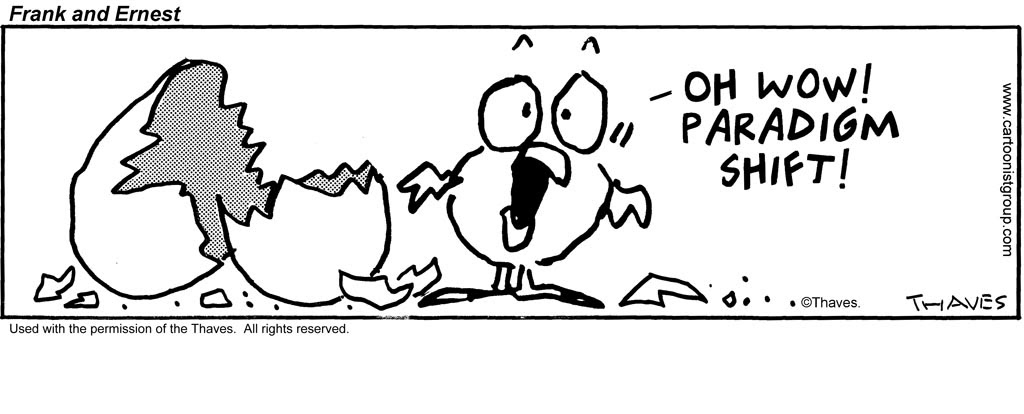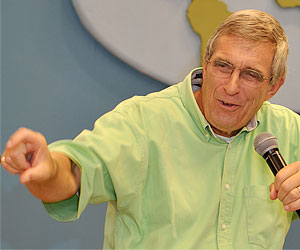Beauty comes from God. The most beautiful thing you have ever seen is beautiful because it reflects God. The most hideous thing you have ever seen is hideous because it distorts God’s nature. Part of our task in the Great Commission, connected to the Cultural Commission, is to create beauty.
Cynthia Pearl Maus (1880–1970) wrote,
God wrought beauty in the structure of the universe. Beauty is the high form of righteousness. Beauty and truth are not separated in God’s world, and they are not to be in human thought. . . . God, who gave as much care to paint a lily as to forming the eternal hills, joined truth and beauty in holy union; and what God has joined together man ought not attempt to put asunder, because beauty has a moral value for truth.[i]
Beauty is a moral necessity, fused with goodness and truth. On the other hand, the hideous is not simply ugly; it is fused with evil and lies.
The Bible describes how the First Artist communicates through his artistry.
Lift your eyes and look to the heavens: Who created all these?
He who brings out the starry host one by one, and calls them each by name.
Because of his great power and mighty strength, not one of them is missing. Isaiah 40:26
God’s art (creation) reveals his existence and the elements of his transcendent nature. It reveals the design, structure, and purpose of humankind and the wonder and nature of creation.
Human art should imitate God’s artistry
Human beings were given the task of creating godly culture. They were equipped with hands to cultivate the soil and with minds and hearts to cultivate the soul. The fundamental question is: Will these works of art reflect beauty or the hideous? Will they breathe life or bring death? In making life-affirming art, the artist—the secondary creator—reveals the Primary Creator. The artist’s secondary world reflects the wonder and reality of the primary world.
C.S. Lewis (1898–1963), Christian apologist and academic, describes the work of the artist: “An author should never conceive of himself as bringing into existence beauty or wisdom which did not exist before, but simply and solely as trying to embody in terms of his own art some reflection of that eternal Beauty and Wisdom.”
An artist’s expression is a reflection of her worship. Art will contribute either to a toxic culture or a healthy one; it will promote life or death. When laws of creation are honored and biblical principles applied, the artist’s expression will glorify God and contribute to the building of a godly nation.
Dr. Elizabeth Youmans writes of the influence of the Bible on art: “In nations where the Bible has highly influenced language, law, and culture, the fine arts reflect beauty, truth, and moral goodness. When the Bible has not been an influence or has been removed as the seedbed of language and culture, the fine arts reflect the corruption and debasement of beauty, truth, and moral goodness.”
Beauty is not merely in the eyes of the beholder
As truth stands opposed to lies, and good to evil, so does beauty to the hideous. Just as there is an objective truth and goodness, so there is a tangible standard of beauty. Relativists claim that “beauty is in the eye of the beholder.” But absolute beauty has an objective standard: the glory and splendor of God. True beauty is permeated with truth and goodness just as God is beautiful, true, and good. In their creativity, people contribute to culture that either edifies or tears down. They create culture that either nurtures the human spirit and refines nations, or poisons the soul and pollutes society. Father Thomas Dubay writes about the power of music to influence us: “In touching the inner core of our beings beautiful music ennobles and uplifts. It possesses a persuasive power towards the good, while coarse and barbaric music cheapens, degrades, and promotes evil.”22
At least four critical ingredients characterize good art: artistry, content, order, and technique.
 Artistry is the ability to stir the soul. John R. Erickson, creator of the children’s book series Hank the Cowdog, writes, “Young writers should be speaking out against stories that are formless, chaotic, selfish, and disgusting. Their mission should be to do what artists deserving of the title have always done: bring light into the world, find order in chaos, and provide nourishment, hope, and meaning to people who need it.”
Artistry is the ability to stir the soul. John R. Erickson, creator of the children’s book series Hank the Cowdog, writes, “Young writers should be speaking out against stories that are formless, chaotic, selfish, and disgusting. Their mission should be to do what artists deserving of the title have always done: bring light into the world, find order in chaos, and provide nourishment, hope, and meaning to people who need it.”
Tolkien describes successful story telling
The content of the artist’s expression reveals reality and the glory of God. Joy is found when an artistic creation reveals something of God’s glory. God’s artistry reveals his glory. It is found when reality is discovered in the midst of artistic expression.
In his treatise on fantasy, Tolkien writes: “The peculiar quality of the ‘joy’ in successful Fantasy can thus be explained as a sudden glimpse of the underlying reality or truth. It is not only a ‘consolation’ for the sorrow of this world, but a satisfaction, and an answer to that question, ‘Is it true?’ … If you have built your little world well, yes: it is true in that world.”
The order of the artistic expression moves toward coherence and harmony. Physicist Paul Davies describes the relationship between beauty and order: “Time and again, the artistic taste has proved a fruitful guiding principle and led directly to new discoveries, even when it at first sight appears to contradict the observational facts. . . . Central to the physicist’s notion of beauty are harmony, simplicity, and symmetry.”
The technique of the artist is to reveal excellence. Not only the art’s content but also its excellencies bring joy to the observer because they point to the glory of the First Artist. Dubay describes the radiance of perfection in a piece of art: “Michelangelo’s Pieta is light in stone. Its radiance not only delights the observer but also simultaneously shouts that it came about not by a chance erosion caused by unknowing elements of water and wind. Its form, integrity, proportion, and radiance declare both its message and the design of the master who produced it.”
Let’s create more beauty
 Individuals and nations can produce more beauty and less vulgarity, more harmony and less dissonance. A hallmark of L’Abri Fellowship, founded by Francis and Edith Schaeffer, was everyday beauty: beautifully served meals, fresh-cut flowers and candles on the table, classical music in the background.
Individuals and nations can produce more beauty and less vulgarity, more harmony and less dissonance. A hallmark of L’Abri Fellowship, founded by Francis and Edith Schaeffer, was everyday beauty: beautifully served meals, fresh-cut flowers and candles on the table, classical music in the background.
From L’Abri, I visited a mission base in Austria that smuggled Bibles behind the Iron Curtain. The disparity was striking. In contrast to the simple beauty at L’Abri, the base meals were like army rations, served in cooking pots placed unceremoniously on the table and eaten from plastic plates. The dining room was dark and drab.
This mission base was functioning from a stark war mentality. Yes, we are in a conflict, but beauty can be brought even to the battle.
Too much that passes for art in the West today is steeped in lies and darkness: immorality, vulgarity, the objectification of women, eroticism, the promotion of drug abuse and homosexuality. All these lead to bondage and death rather than freedom and life. We should oppose such counterfeit “beauty” in our society.
We are all culture makers, given the task of creating beauty marked by goodness and truth. We are artists in our homes as we prepare and present meals, as we decorate. In the office we can create an aesthetically pleasing workplace with quiet music, artwork, and plants. The factory can be a clean, healthy environment for workers with splashes of beauty.
Let us be creators of beauty. Let us live out the aesthetic order, together with the moral and metaphysical orders, as we anticipate the fulfillment of God’s kingdom.
- Darrow Miller
This DM&F Classic blog post is excerpted from the book Emancipating the World. For the entire text go here.
[i] Christ and the Fine Arts: An Anthology of Pictures, Poetry, Music, and Stories Centering on the Life of Chri






